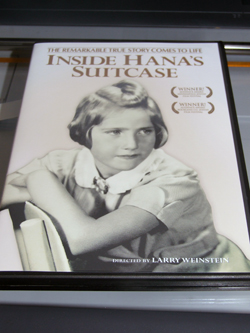
Inside Hana’s Suitcase directed by Larry Weinstein, Menemsha Films, 90 minutes, DVD on sale Dec. 6.
By Donald H. Harrison
 SAN DIEGO–The world might not know the name Hana Brady except for the fact that a replica of the suitcase which the 13-year-old girl carried on the train from the Theresienstadt concentration camp to Auschwitz was sent for exhibit nearly six decades later to a Holocaust education center in Tokyo, Japan.
SAN DIEGO–The world might not know the name Hana Brady except for the fact that a replica of the suitcase which the 13-year-old girl carried on the train from the Theresienstadt concentration camp to Auschwitz was sent for exhibit nearly six decades later to a Holocaust education center in Tokyo, Japan.
The exterior of the suitcase gave little more information than the name of the child who carried it, and the fact that she was an orphan. Inside the case, for exhibit, was an empty can of the gas used to murder Jews at Auschwitz, as well as a sock, representing a personal item of Hana’s clothing.
Hana was but one of 1.5 million children murdered during the Holocaust, but such an artifact as a suitcase made her story an individual one that perhaps modern-day children could understand. Educator Fumiko Ishioka carefully measured the suitcase so it could be displayed in a glass display case and, encouraged by the curiosity of the students she taught at the center, she set about trying to learn whatever she could about this child Hana who was selected for death at the Auschwitz train station.
Ishioka’s search for Hana took her to the Jewish museum in Prague and then to Theresienstadt where it turned out Hana had spent most of the last two years of her life. A curator at Theresienstadt helped find Hana’s name among the list of the 90,000 inmates who had passed through that concentration camp and ghetto. A check mark by Hana’s record indicated that she had not survived the Holocaust. But there also was a box around the record for a Georg Brady, indicating he was a survivor. Could he have been a relative of Hana’s? Ishioka wondered.
Indeed, Georg was Hana’s brother. Perhaps, suggested the curator, one of the survivors who keeps in touch regularly with the Theresienstadt museum might know of him, or have heard from him. Following up, Ishioka learned that one man–who had been in the same barracks as Georg Brady–did indeed remember. He said Georg was still a friend, and was now living in Toronto, Canada.
Georg meanwhile had raised four children–three sons and a daughter, Lara Hana Brady, named for his sister. He doted on them and his grandchildren, and although he told his family that he had been in the concentration camps, he tried to avoid talking about his experiences. He didn’t want to inflict the pain on them.
When he received a letter from Ishioka asking questions about Hana and asking for any photographs or other keepsakes so that children in Japan could learn how important it is not to hate, Georg was moved. He complied with the request, and said that he would like to come and see the suitcase as well as to meet the students who were so interested in his dead sister. From that point on, Georg became a Holocaust educator himself, telling his story–and that of his sister–to school children.
His meeting with the students in Japan is one of the emotional points of the film that tells about the life of Hana not only in sepia-toned, re-created flashbacks, but also through the straightforward narrations of students in the Japanese school, a Canadian school, and in a school in Georg’s and Hana’s hometown of Nove Mesto, Morava, in the Czech Republic.
During the film, which was prompted by the best-selling book by Karen Levine, we meet Georg and his daughter Lara as they go back to the Czech Republic and retrace the steps of Georg’s and Hana’s Holocaust journey. In Japan, we meet a survivor of Hiroshima who volunteers at the Holocaust Museum. The two tragedies were not at all alike, she says. In the Holocaust, the Jews were singled out because of how they were born, whereas the atomic bombing at Hiroshima was not aimed at individuals, it was the result of a war that Japan had started.
This documentary, which will be available Dec. 6 on DVD, is valuable on so many levels. Yes, it tells a Holocaust story in personal terms that permit this generation of children to identify with the victimized children of their grandparents and great-grandparents generations. It also introduces the children to some methodologies–and the excitement — of historic research. And in having the children retell Georg and Hana’s story — in Japanese, Czech and English — it demonstrates that whatever children’s outward differences, their common humanity binds them together.
*
Harrison is editor of San Diego Jewish World. He may be contacted at donald.harrison@sdjewishworld.com
From:
Erika Gray
gray_erika@optusnet.com.au
Message:
Relayed message to editor:
I would like to know if ‘Inside Hana’s Suitcase’ Dvd is available in a
Region 4 format for viewing by Austraian audiences please.I have the
documentary saved to my hard drive, but would like to share the story
and wonderful documentary with others.I reside in Australia and cannot
view Region 1 dvd’s on my player, and to date I have only seen the dvd
available in this regional format.Hoping someone may be able to assist
me. Thanking you.
Erika Gray